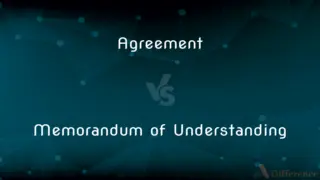Grand Jury vs. Petit Jury — What's the Difference?
By Maham Liaqat & Fiza Rafique — Published on June 25, 2024
A grand jury determines whether there's enough evidence for a criminal case to go to trial, without deciding guilt, while a petit jury, also known as a trial jury, decides the verdict of a trial based on evidence presented.

Difference Between Grand Jury and Petit Jury
Table of Contents
ADVERTISEMENT
Key Differences
A grand jury is a legal body empowered to conduct official proceedings to investigate potential criminal conduct and determine whether charges should be brought. It consists of a larger group of citizens, typically ranging from 16 to 23 members, depending on the jurisdiction. Grand juries operate in secrecy, reviewing evidence presented by prosecutors to decide if there is probable cause to believe a crime was committed and whether an indictment should be issued.
Petit juries, on the other hand, are smaller, typically composed of 6 to 12 members, depending on the jurisdiction and the case type. These juries are convened for the trial phase of both criminal and civil cases. They listen to the evidence presented by both the prosecution and defense, including witness testimony, and then deliberate to reach a verdict. The proceedings of a petit jury are public, and their primary role is to determine the guilt or innocence of a defendant in criminal cases or the liability and damages in civil cases.
The grand jury's role is preliminary and investigative, serving as a check on prosecutorial power by requiring the government to present sufficient evidence before bringing someone to trial. In contrast, the petit jury serves a decisive role, making the final determination on legal disputes based on the evidence presented during the trial. This structure ensures that individuals are not subjected to public trial without a preliminary assessment of the evidence against them.
Both types of juries are fundamental to the American legal system, offering citizens a unique role in the administration of justice, while their functions, procedures, and impacts on a case are distinct. Grand juries are about the initiation of prosecutions, and petit juries are about the resolution of trials. This division underscores the balance between the need to investigate and prosecute crimes and the right of individuals to a fair and impartial trial.
Comparison Chart
Purpose
Determine if there's enough evidence for a trial.
Decide the verdict of a trial.
ADVERTISEMENT
Size
16-23 members.
6-12 members.
Proceedings
Secret, not open to the public.
Public, open to the public.
Decision
Issues indictments.
Renders verdicts.
Role in the Legal System
Investigative and initiatory.
Decisive and final judgment.
Operation
Reviews evidence presented by the prosecution.
Listens to evidence and testimony from both sides.
Outcome
Does not determine guilt or innocence.
Determines guilt, innocence, liability, or damages.
Compare with Definitions
Grand Jury
Does not determine guilt or innocence.
The grand jury's role was only to decide if the case should proceed to trial.
Petit Jury
Final judgment on legal disputes.
The petit jury's verdict ended the lengthy legal battle.
Grand Jury
Issues indictments based on probable cause.
After reviewing the evidence, the grand jury issued an indictment against the accused.
Petit Jury
Public proceedings ensure transparency.
The trial was open to the public, with the petit jury listening to all evidence presented.
Grand Jury
Consists of 16 to 23 members.
A 23-member grand jury was convened to examine the high-profile case.
Petit Jury
Typically composed of 6 to 12 members.
A 12-member petit jury was selected for the murder trial.
Grand Jury
Operates in secrecy to review evidence.
The grand jury's proceedings were closed to protect the investigation's integrity.
Petit Jury
Decides the verdict in criminal and civil trials.
The petit jury found the defendant guilty of the charges.
Grand Jury
A legal body determining if enough evidence exists for a trial.
The grand jury indicted the defendant, leading to a criminal trial.
Petit Jury
Renders verdicts on guilt, innocence, or liability.
The petit jury deliberated for hours before reaching a verdict on liability.
Common Curiosities
Why are grand jury proceedings secret?
To protect the reputation of potential defendants, encourage witnesses to speak freely, and prevent tampering with the jury or evidence.
What determines the number of members in a grand or petit jury?
The number is determined by law and can vary depending on the jurisdiction and the type of case being heard.
What happens if a grand jury does not indict?
If a grand jury does not issue an indictment, it means they found insufficient evidence to proceed to trial, and the accused may be released from the charges.
How are jurors selected for each type of jury?
Jurors are selected from the community, typically through a random process from voter registrations or driver’s license lists, and then vetted for suitability.
Can a grand jury investigation lead to multiple indictments?
Yes, a grand jury can issue multiple indictments if they find probable cause for different crimes or against multiple individuals.
Is the verdict of a petit jury always final?
While the verdict is final, it can be appealed to a higher court if there are grounds to believe legal errors affected the trial's outcome.
What role does the judge play in a grand jury?
Judges do not typically preside over grand jury proceedings but may be involved in supervising the legal framework and ensuring the process adheres to legal standards.
Do all criminal cases go through a grand jury?
Not all cases require a grand jury indictment; it depends on the jurisdiction and the severity of the charges.
Can someone serve on both types of juries?
While individuals may serve on both types of juries, they cannot serve on both for the same case due to their distinct functions.
Why might a petit jury have fewer members than a grand jury?
Petit juries have fewer members because their role is more focused on deliberating and deciding on specific cases, rather than reviewing a broad range of evidence for potential indictments.
What rights do defendants have during grand jury proceedings?
Defendants generally do not have the right to present evidence or testify before a grand jury, as the proceedings are one-sided to evaluate the prosecution's case for probable cause.
Can the findings of a grand jury be challenged?
The indictment itself is not usually challenged; however, the evidence leading to a trial can be contested during the trial phase.
How does the public learn about grand jury indictments?
Indictments are typically made public once issued, but the evidence and testimony presented during the proceedings remain confidential.
What happens if a petit jury cannot reach a unanimous verdict?
If a petit jury cannot reach a unanimous verdict, it may result in a hung jury, leading to a mistrial, and the case may be retried with a new jury.
Share Your Discovery

Previous Comparison
Agreement vs. Memorandum of Understanding
Next Comparison
Google Drive vs. OneDriveAuthor Spotlight
Written by
Maham LiaqatCo-written by
Fiza RafiqueFiza Rafique is a skilled content writer at AskDifference.com, where she meticulously refines and enhances written pieces. Drawing from her vast editorial expertise, Fiza ensures clarity, accuracy, and precision in every article. Passionate about language, she continually seeks to elevate the quality of content for readers worldwide.













































